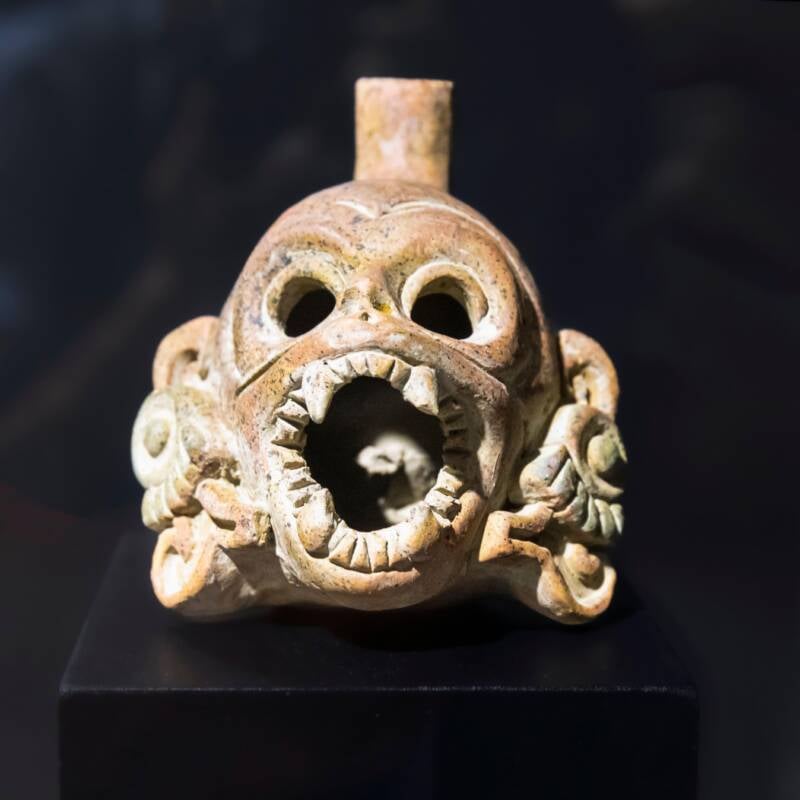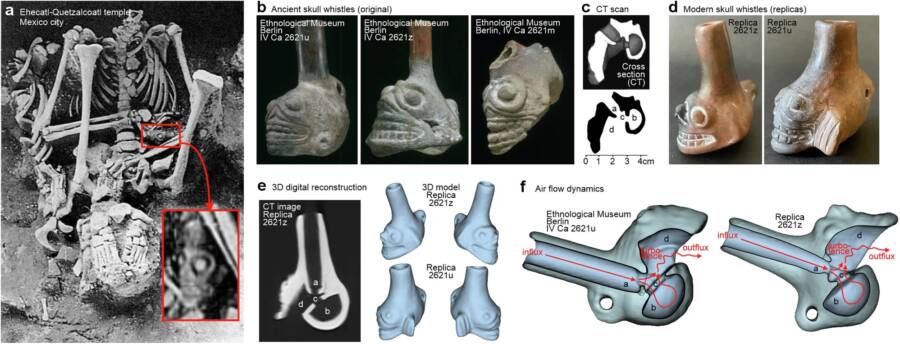Researchers discovered that the sound of the Aztec death whistle lies in an auditory version of the uncanny valley in which the listener can't quite tell whether its shriek is human or not.

Classic Image/Alamy Stock PhotoAn Aztec death whistle in the shape of a human skull.
Aztec culture remains uniquely fascinating in part due to its various religious practices that tend toward the macabre, including human sacrifice and temples decorated with human skulls. But one of the most intriguing — and terrifying — of their creations was the Aztec death whistle, a skull-shaped ceramic instrument said to emit the most horrifying noise in history.
Many have likened the sound produced by the death whistle — or the ehecachichtli, as it was originally known — to the shriek of a banshee, the howl of the wind, the screams of the damned, or even the “wail of a thousand souls.” But it always remained unclear why these whistles were so effective at instilling fear in all who heard them.
Now, researchers have an answer. For the first time, scientists have studied the effect of the Aztec death whistle’s sound on listeners’ brains, and the results are fascinating.
What Were Aztec Death Whistles And What Did They Sound Like?

Wikimedia CommonsAztec death whistles have been said to produce a sound like the “wail of a thousand souls.”
Aztec death whistles, or skull whistles, are small, skull-shaped clay instruments from ancient Mesoamerica, particularly associated with the Aztec civilization. They were first discovered by researchers in 1999, and have been a source of historical fascination ever since.
Since their initial discovery, numerous skull whistles have been recovered from ancient Aztec sites, most commonly from the graves of sacrifice victims. When blown, these whistles emit a chilling, high-pitched sound that resembles, simultaneously, a human scream and howling wind. This eerie sound is produced by the unique internal structure of the whistle, which creates air turbulence to create its distinctive tone.
The unsettling nature of these whistles has sparked much debate about their original intended purpose. Some scholars suggest they were used in sacrificial ceremonies to symbolize the wind or guide souls to the afterlife. It is also believed that the noise they produced was meant to evoke the Aztec wind god Ehecatl, or perhaps the god of death Mictlantecuhtli.

Public DomainMictlantecuhtli as portrayed in the Codex Magliabechiano.
Others propose that the whistles served as psychological weapons in warfare, designed to instill fear in the enemy. That said, there is limited evidence to support this claim, given that such whistles have not been found at battle sites or in warriors’ graves.
To help settle this debate, researchers decided to conduct a study to explore the psychoacoustic effects of Aztec death whistles to identify how exactly the human brain responds to its sound.
New Research Shows How The Aztec Death Whistle’s Sound Affects Listeners’ Brains

Frühholz, S., Rodriguez, P., Bonard, M. et al.Figures from the analysis of the psychoacoustic effects of Aztec death whistles.
The results of the study were published in a new report in Communications Psychology, explaining how researchers used “psychoacoustic listening and classification experiments” to analyze the effect of the Aztec death whistle on the study’s subjects.
What researchers found is that the sounds produced by the death whistle are “predominantly perceived as aversive and scary and as having a hybrid natural-artificial origin.” This hybrid sound effectively mimicked natural noises like a human scream or wind, but combined that natural sound with something that could be classified as artificial or technological — in a sense, entirely un-humanlike.
In other words, the reason that human brains react with such terror to the sound of an Aztec death whistle is that the instrument essentially creates an audio version of the “uncanny valley,” a term that describes the eerie, unsettling effect of something that seems almost human, but not quite.
“Human listeners in our experiments rated skull whistle sounds as very negative and specifically labeled them largely as scary and aversive, which potentially also trigger urgent response tendencies and interfere with ongoing mental processes,” the study’s authors wrote. “This immediacy effect is further highlighted by very specific brain activity in low-order [auditory cortical regions] that is correlated with the affective similarity of [skull whistles] to other sounds.”
Notably, the research team tested the effects of both original Aztec-made death whistles and modern replicas, finding that both achieved the same effect. Knowing now that the sound produced by death whistles is inherently unsettling to humans could also help further explain how these instruments were once utilized by the Aztecs.

Communications PsychologyBrain areas triggered by the Aztec death whistle during the recent study.
“Aztec communities might have capitalized on this aversive and scary nature of skull whistle sounds in specific contexts, which would support the introduced warfare and ritual symbolism hypothesis, but rather not the deity symbolism hypothesis,” researchers wrote.
They argue, however, that death whistles being used in warfare “seemed rather unlikely,” largely due to how the Aztecs associated this horrifying sound with their deities. It is more likely, researchers concluded, that the whistles were used in sacrificial rites and burial ceremonies.
“Skull whistles might have been used to scare the human sacrifice or the ceremonial audience, but further cross-documentation is needed here. The symbolic and associative meaning might be specifically related to the dangerous and scary travel of the dead to the underworld,” they wrote.
There’s still much to uncover about the Aztec death whistle, but this study makes it clear that whatever their intended use, they were uniquely terrifying by design in ways that have remained true for centuries.
After learning about how Aztec death whistles affect the human brain, explore Mexico’s stunning Aztec pyramids. Then, meet Xipe Totec, the Mesoamerican god of human flaying.





